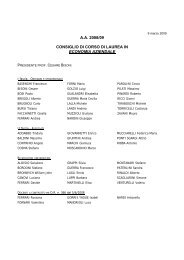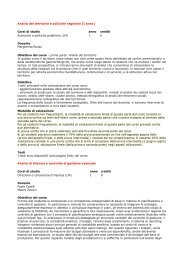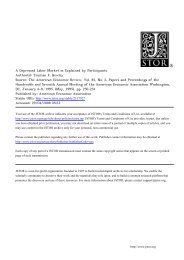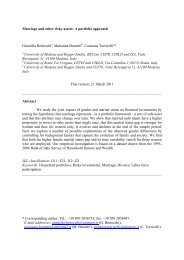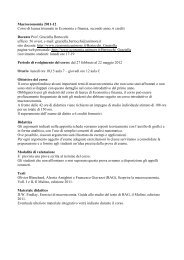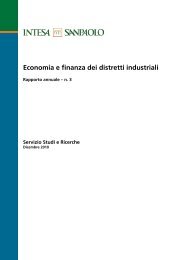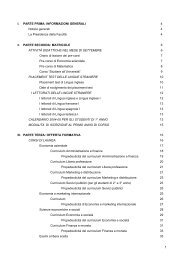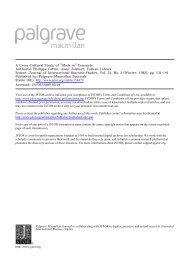You also want an ePaper? Increase the reach of your titles
YUMPU automatically turns print PDFs into web optimized ePapers that Google loves.
perceived and interpr<strong>et</strong>ed differently by individu<strong>al</strong>s within a specific country. In fact,these cues tend to be ev<strong>al</strong>uated by consumers in a different way for each foreigncountry, this being the outcome of contacts, associations with, or previous experiencesof the country, its people, and its products (Eroglu and Machleit, 1989; Hanne, 1996).Country-of-origin ev<strong>al</strong>uations consist of positive ev<strong>al</strong>uations for certain cues andnegative ev<strong>al</strong>uations for others, the combined effect of which conveys the image of aspecific product. Moreover, the significance of each product cue for the consumer tendsto change over time, due to increased exposure to a foreign country, informationreceived from various sources, or an actu<strong>al</strong> improvement/d<strong>et</strong>erioration in goods in thesource country (Nagashima, 1970, 1977). Furthermore, consumer attitudes towardcountry-of-origin tend to be influenced by various mark<strong>et</strong>ing tools, such as aggressivepromotion, attractive store presentation, and price concessions (Chao, 1998). Firmsoriginating from more-developed economies, like the US, are in a b<strong>et</strong>ter position toprovide adequate mark<strong>et</strong>ing support for their products abroad, as opposed to theircounterparts from less-developed countries, like China, which lack proper managementand mark<strong>et</strong>ing skills (Zhang, 2002; Dollan and Hardy, 2002). However, as opposed toUS-made goods, Chinese products have the advantage of being sold at a lower price,due to the cheap labor force, abundance of raw materi<strong>al</strong>s, and government subsidies(Zhang, 2002). The different emphasis attached by consumers to each cue is expected toprevail at different levels of an<strong>al</strong>ysis (i.e. country, industry, product, brand, and model),irrespective of country. The previous discussion leads to the following propositions:H2a. There are significant differences among the ev<strong>al</strong>uations of British consumersof the various cues of goods made in the US at the country, industry, product,brand, or model levels.H2b. There are significant differences among the ev<strong>al</strong>uations of British consumersof the various cues of goods made in China at the country, industry, product,brand, or model levels.US versusChinese goods799Country-of-origin and environment<strong>al</strong> similarityCountry-of-origin ev<strong>al</strong>uations seem to be affected by the similarity perceived byconsumers with their home countries in terms of economic, socio-cultur<strong>al</strong>,politic<strong>al</strong>-leg<strong>al</strong>, and other environment<strong>al</strong> aspects (Papadopoulos <strong>et</strong> <strong>al</strong>. 1990a, b).Moreover, empiric<strong>al</strong> evidence have shown that there is a positive relationship b<strong>et</strong>weenproduct ev<strong>al</strong>uations and degree of economic development, with products made inless-developed countries usu<strong>al</strong>ly rated by consumers as inferior to those manufacturedin more-developed countries (Schooler, 1971; Hampton, 1977; Wang and Lamb, 1983;Bannister and Saunders, 1978). This is more likely to be the case of products with <strong>al</strong>arge technologic<strong>al</strong> content, as well as those requiring a high level of consumerinvolvement. Even “new manufacturing countries”, like China, often have a reputationfor lower qu<strong>al</strong>ity, despite efforts to imitate the products of more-developed countries,like the US, which have a long-established and a widely-proliferated manufacturingsector (Zhang, 2002; Dollan and Hardy, 2002). This can be attributed to the fact thatindustri<strong>al</strong>ized countries have long histories in the manufacture of qu<strong>al</strong>ity products, ar<strong>et</strong>he source of most innovations, and have expertise in producing a wide vari<strong>et</strong>y oftechnologic<strong>al</strong>ly advanced goods (Nagashima, 1970; Gaedeke, 1973; Etzel and W<strong>al</strong>ker,1974). Socio-cultur<strong>al</strong> similarity b<strong>et</strong>ween a purchasing country and a selling country




